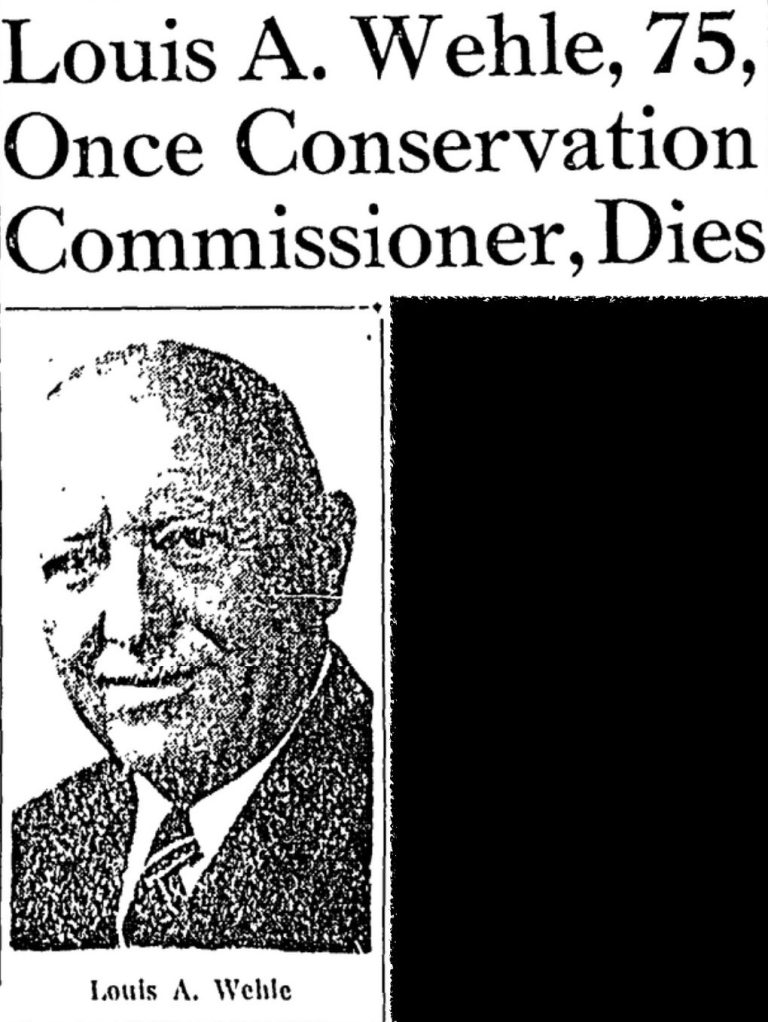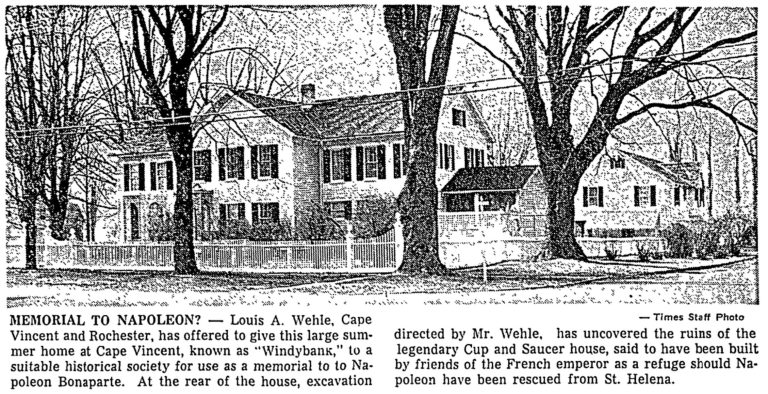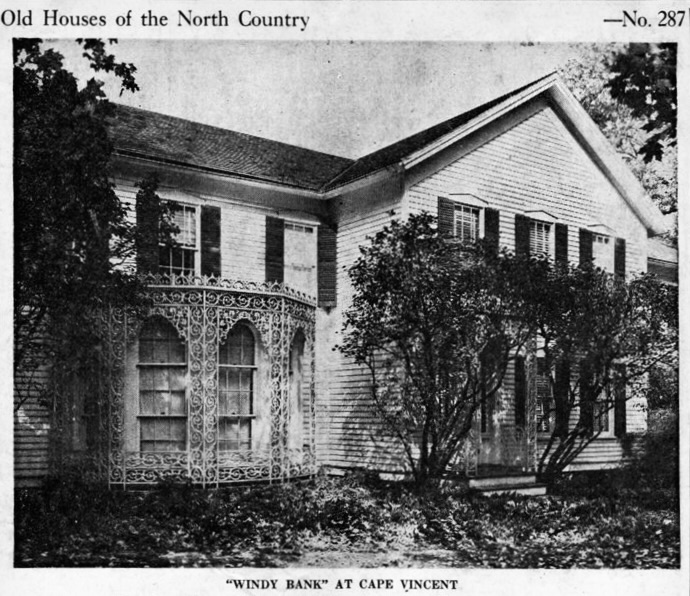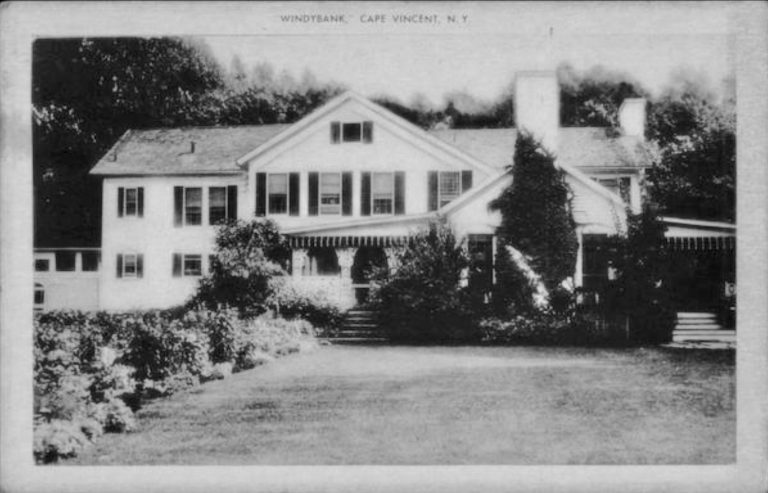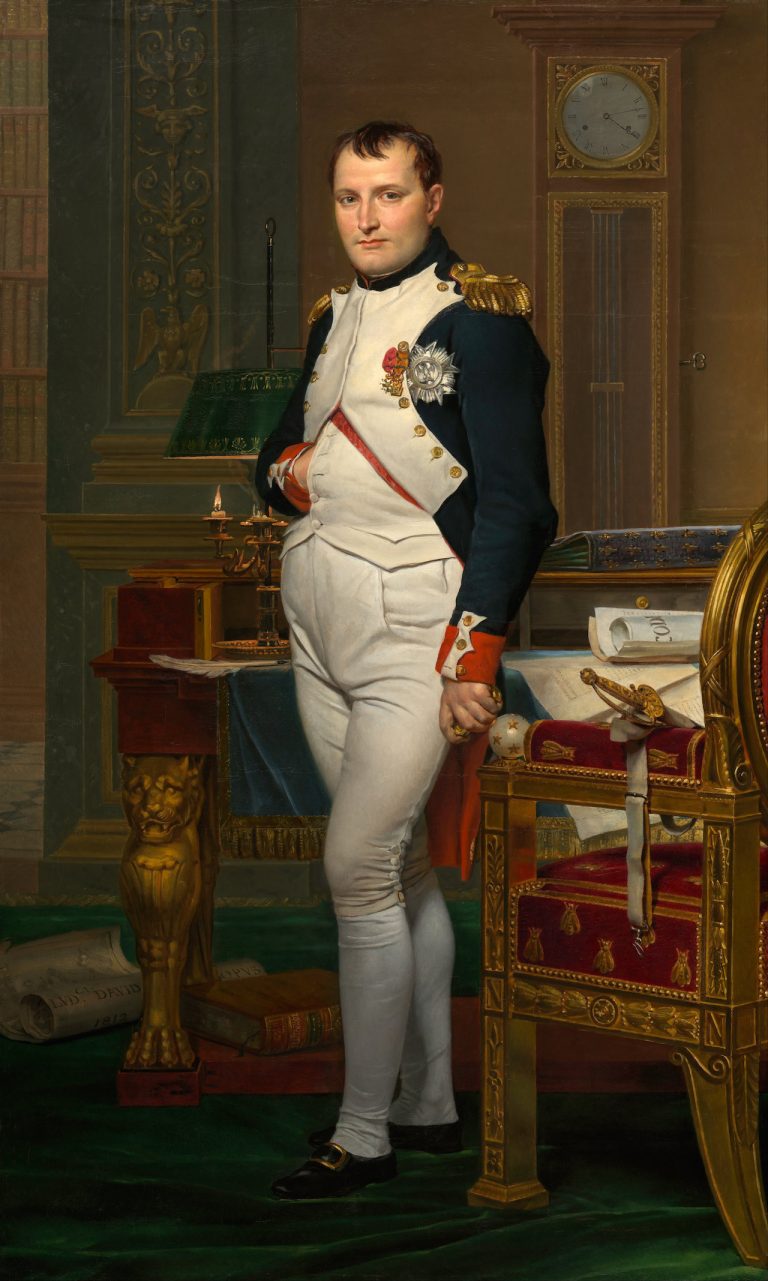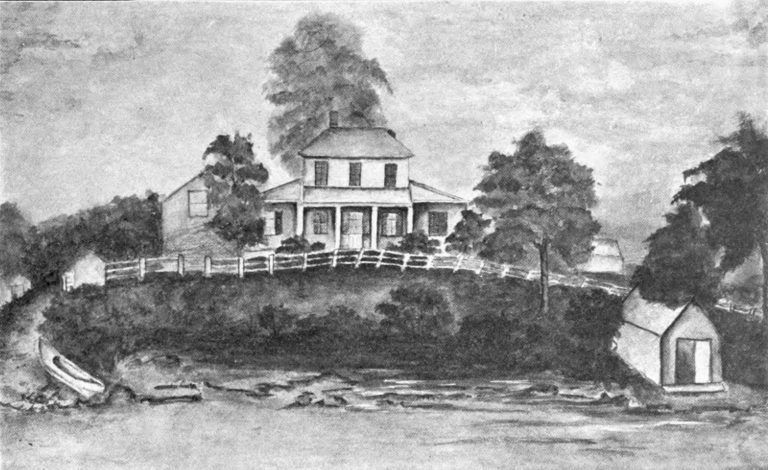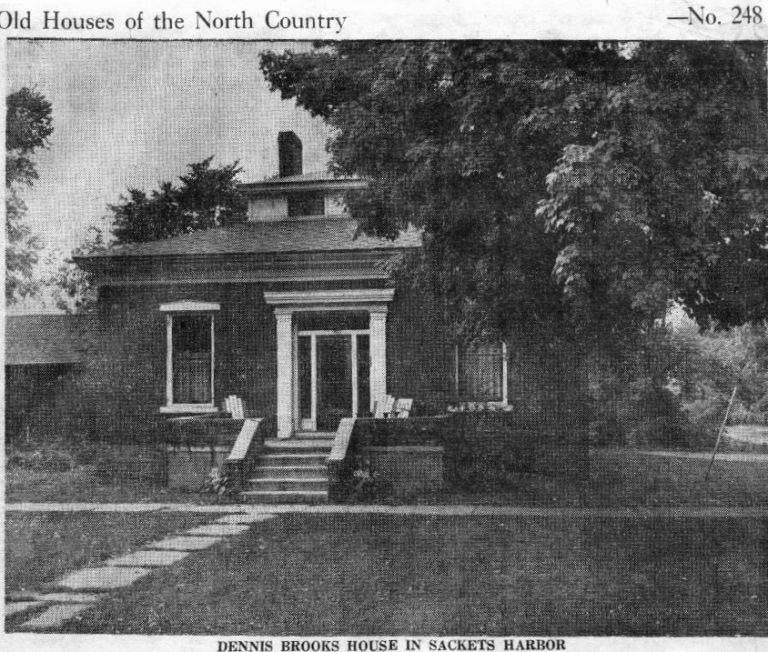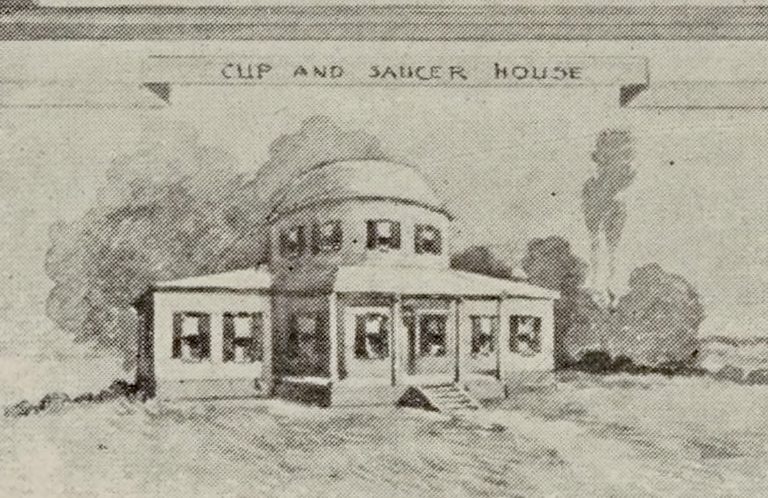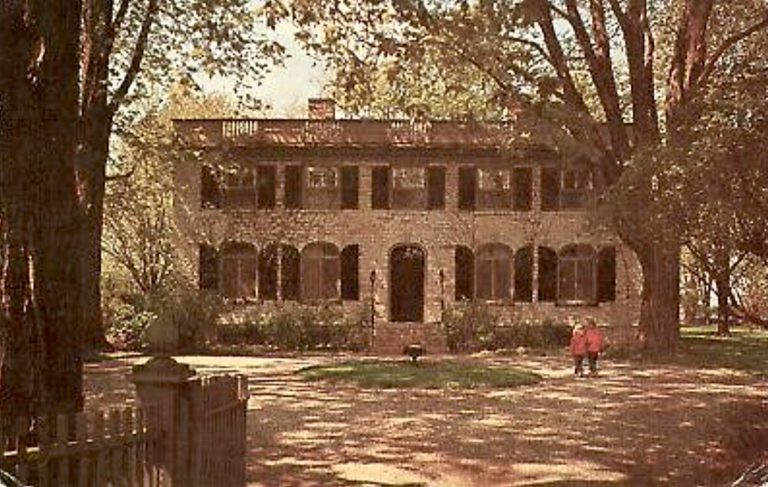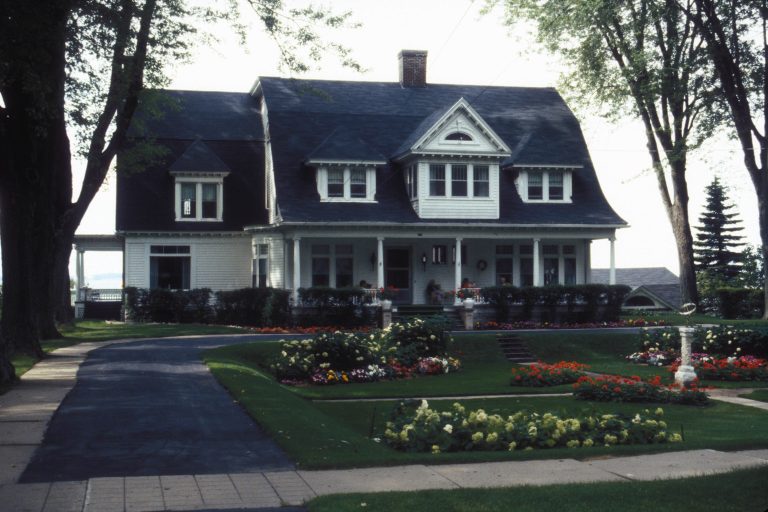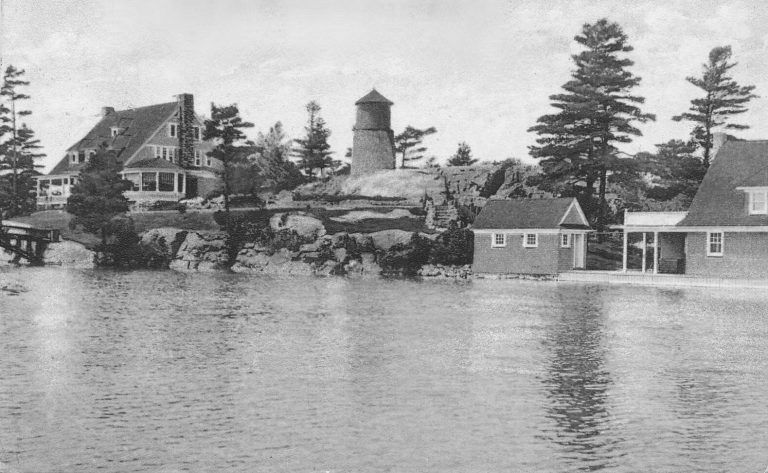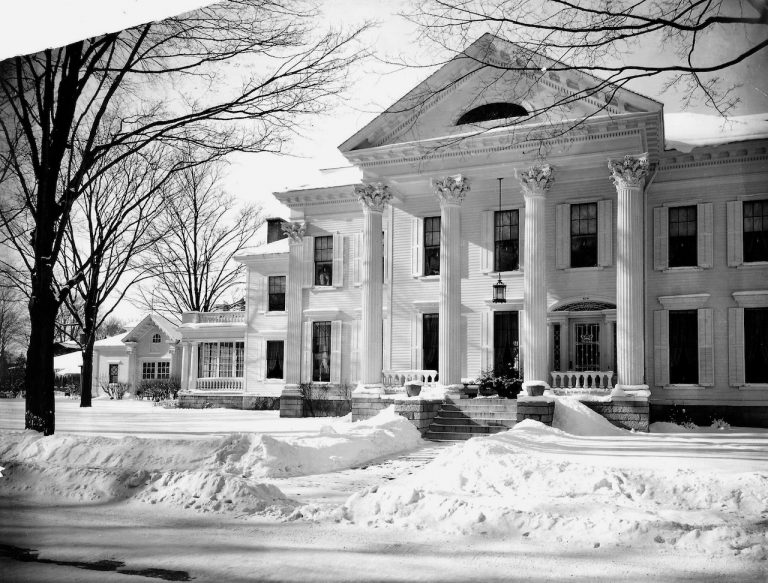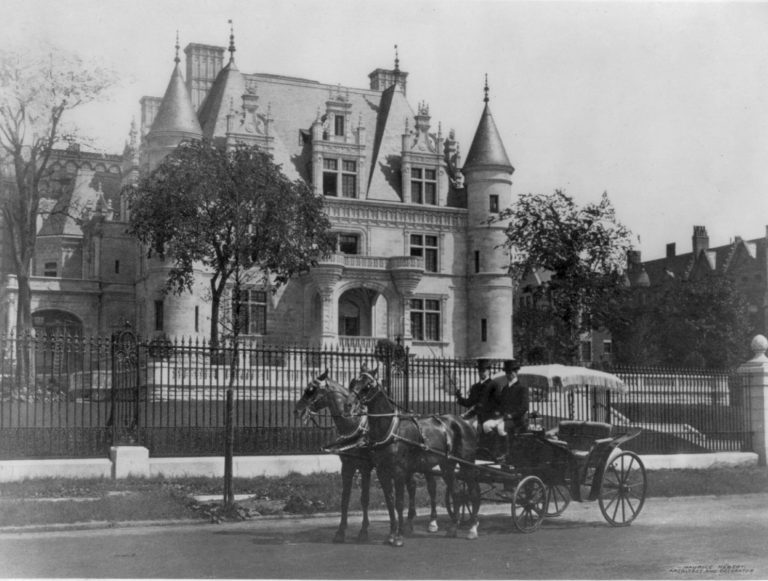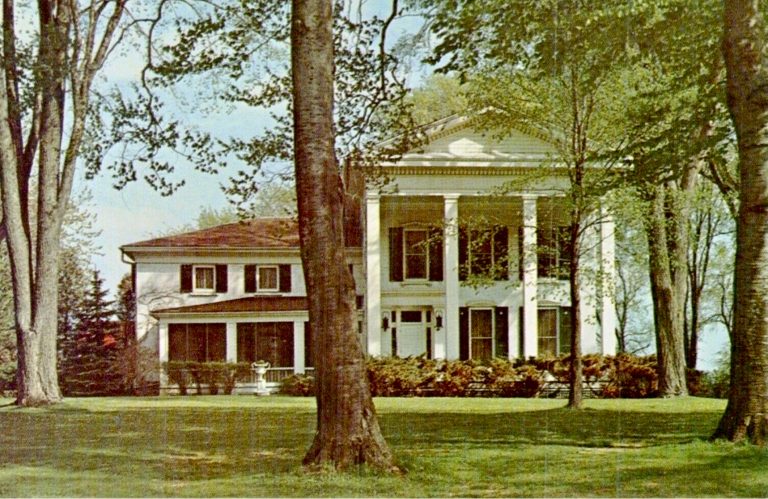The Fascinating History of the Cup and Saucer House In Cape Vincent, Built For Napoleon c.1818
There’s often a tenuous link between past and present, whenever the “present” happens to be. The history of the Cup and Saucer house, reportedly constructed in Cape Vincent for the exiled Napoleon while a team of loyalists planned to free him from St. Helena, is one example where the further from the dates of occurrence events are written about, the less accurate and colored by the tides of time they become.
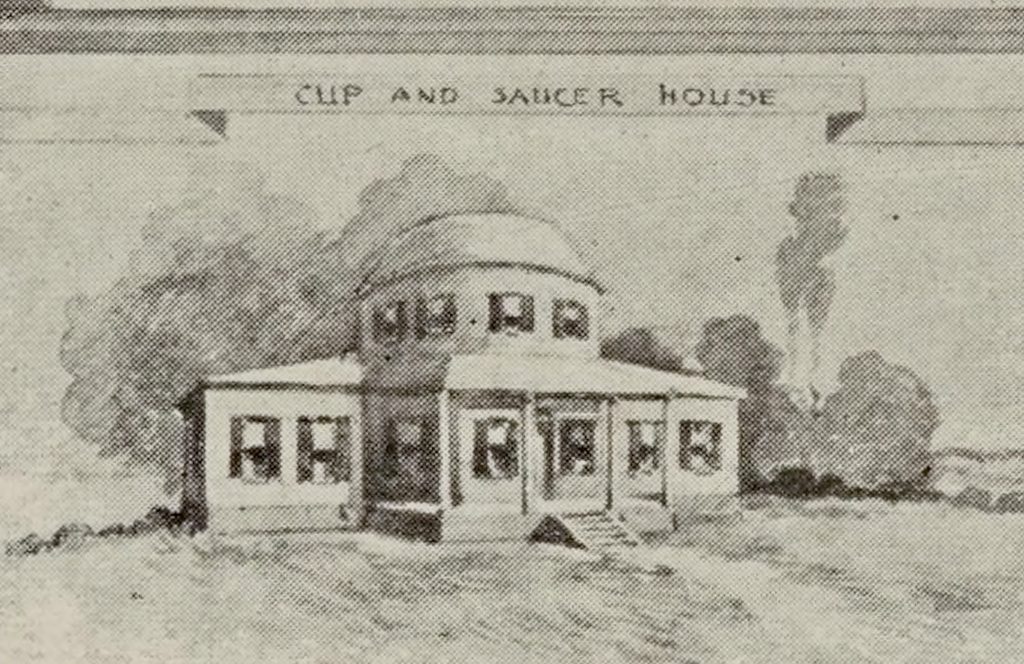
Nevertheless, the Cup and Saucer house has a fascinating, if not altogether romanticized, history, some of which was fortunately captured in local newspapers as far back as 1852. Visitors to the Roswell P. Flower Memorial Library in Watertown may recognize the house from the friezes in the D.A.R. room, painted by nationally known artist Charles F. Naegele, shown above.
A letter to the editor of the New York Reformer, dated July 18, 1852, and later printed on August 5, details a trip to Alexandria Bay and the Thousand Islands, penned only by the name “Yorkino.” It is important to note that the Cup and Saucer house was still standing at the time of Yorkino’s visit, and his letter, of which portions from below are from, provided some historical context as well–
Cape Vincent, known to the oldest inhabitants of this region as Gravelly Point, is at the head of the St. Lawrence River. It is one of the most beautiful and rural of the small villages of this border country, and is not without some pleasing historical associations.
It possesses a most charming resident population, consisting in a large degree of highly cultivated and refined people from La Belle France, who are as distinguished for their hospitality as for their polished cultivation.
It was here that Count Real, Napoleon’s Chief of Police, resided during his exile from France. It is said that the Emperor commissioned the Count to select a place of residence for him in America, should he be able to effect his escape from his prison house at St. Helena. The Count chose Cape Vincent. But the policy of his captors, and their lynx-eyed vigilance, prevented this beautiful village becoming the home of the greatest of Frenchmen.
The house in which Count Real resided, and which was built by him, was pointed out to us. It is sometimes called the cup and saucer house, from its shape.
The Cup and Saucer house was erected just off the shore of the St. Lawrence River, though for many years its precise location was not known, often stated as being on the corner of Broadway and Real Street, or, in one instance, “at the head of Gouvello Street on the west side of Real Street.
A drawing from the well-known book, Cape Vincent and its History, compiled by Nelie Horton Casler and published in 1906 by the Hungerford-Holbrook, Co., of Watertown, N.Y., shown below depicts the Cup and Saucer house as being practically on the river banks, as noted later during the excavation of its ruins in the 1960s.
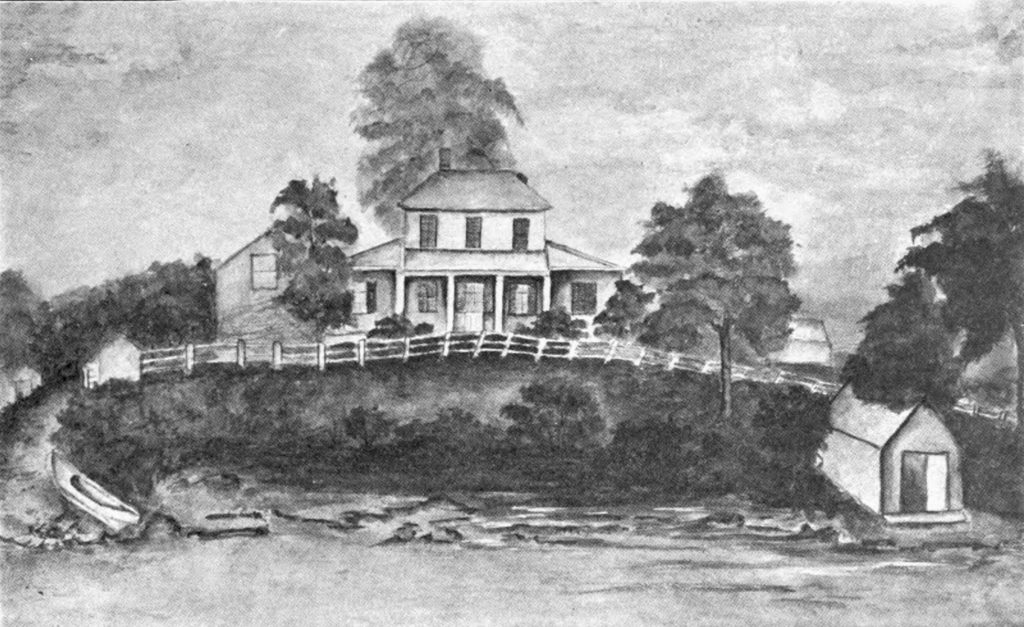
Eschewing its precise location for the moment, the Cup and Saucer house was constructed only a few short years after, and less than 1,000 feet from, the Stone House built for Vincent Le Ray. An article from the Watertown Daily Times, dated December 9, 1881, provided some more information on the house, called over the years as queer, grotesque, and unique–
He (The Count) lived in a hired house for two years and then built a palatial dwelling octagonal in shape, from the centre of which arose the interior portion above the outside, and the building was currently known as the “Cub and Saucer,” from its resemblance to that familiar table article.
The great captive of St. Helena was still alive, and it had been a common tradition is that a plan was laid by these French residents to spirit Napoleon away from St. Helena and bring him to Cape Vincent with the Cup and Saucer house for a home, which was built with that view by Count Real.
The death of Napoleon in 1822 put an end the conspiracy and the carrying out of the original design. Among the eccentric characters of that Napoleonic crowd was Monsieur Pigeon, who never wore anything on his head while Cape Vincent, summer or winter, in pursuance of a vow to continue as long as Napoleon was held a prisoner on his island rock.
In 1849, I visited the old “Cup and Saucer” mansion and found the then-occupant, M. Pagnerre, who had recently been secretary general of the provincial government of 1848 under Lamartine, Dupont De L’Eure, Arogo, Ledru Rollin, Louis Blanc, etc.
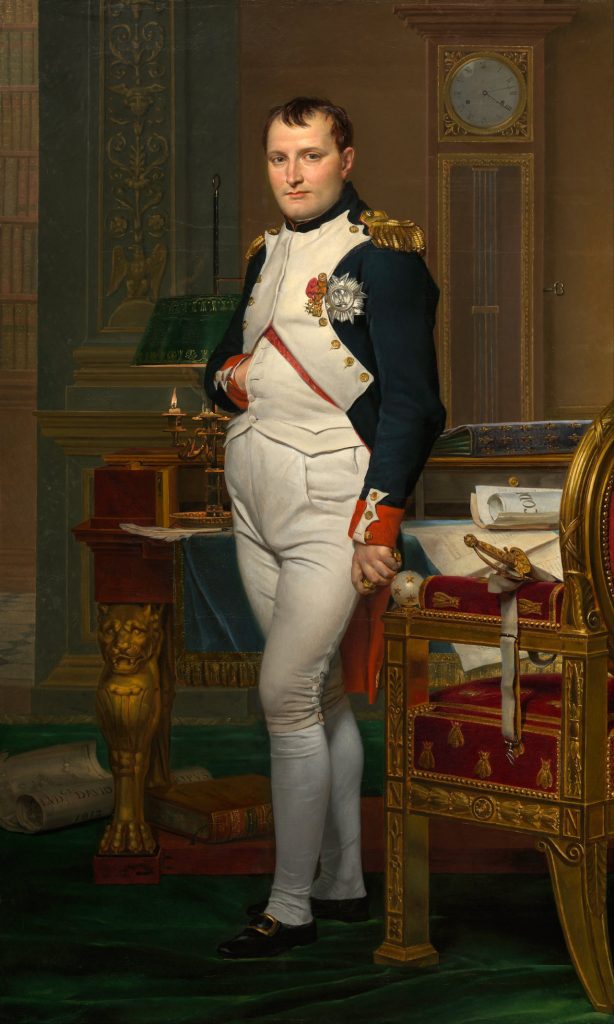
While there’s no question that the Cup and Saucer house never served its original intent, many of the newspaper articles after the turn of the century reported the building sat uninhabited and abandoned for a number of years before burning in 1867. The article above mentions the first-hand account of the author’s visiting the house in 1849 when it was inhabited by M. Pagnerre, but there’s also the history of the nearby Beechwood estate that also confirmed it was occupied at the time.
The original Beechwood, erected by the Crevolins in 1840, was destroyed by fire shortly before the birth of their daughter, Caroline Josephine, in 1854. At the time, the Cup and Saucer house was owned by the Peugnet family, who loaned the home to the Crevolin family during the construction of their new (and the present) Beechwood property.
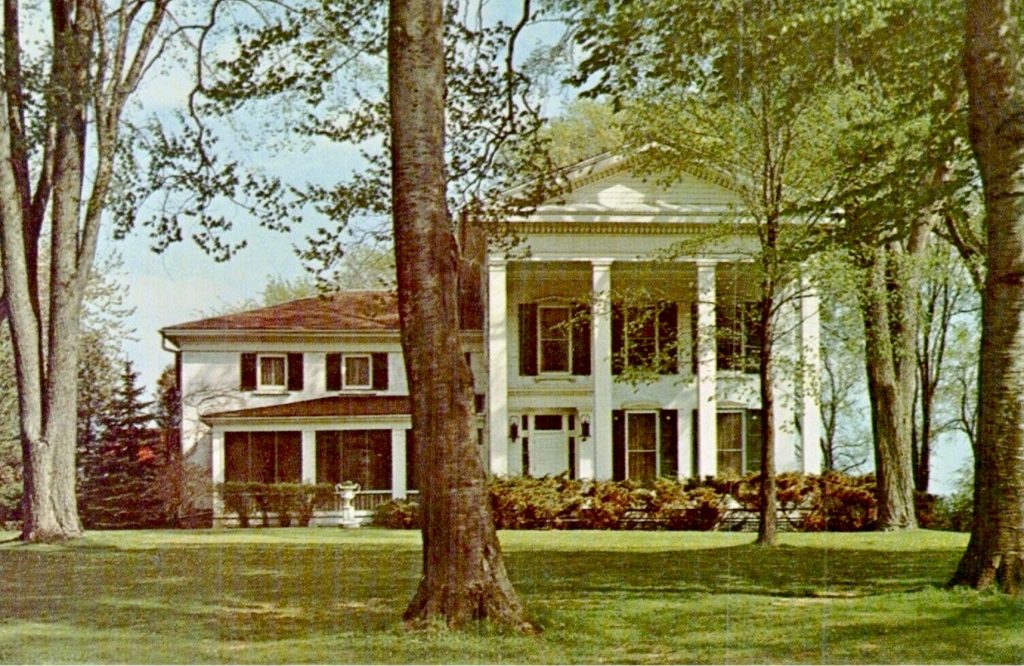
Theophilus Peugnet’s wife at the time was reportedly only 18 years of age, while he was 52. In 1915, Mrs. Bridget E. Fraser, presumably long remarried after Theohilus’s death in 1868, was the subject of an article in the Watertown Daily Times where she provided a first-hand account of just how the property burned down in 1867–
It was magnificently furnished with upholstery and carpets and mirrors and paintings brought at great expense and risk from France. But Napoleon died, and the count died, and the “Cup and Saucer House” became the property of Theophilus Peugnet, a personal friend of Count Real, and himself a refugee from France.
As it happens there now lives in San Antonio, at 309 Jackson Street, Mrs. B. E. Fraser, whose first husband was this same Theophilus Peugnet, the owner of the historic “Cup and Saucer House.” Mrs. Fraser went into the house as a bride—she was 18 and her husband 52. Her first three children were born in the house and she lived there until it burned to the ground one windy winter night in 1867.
Everything was lost in the house, carpets, furniture, paintings, the portrait of Jean Jacques Rousseau, by the French artist, Boucher—everything with the exception of the great mirror from the “Napoleon Room” and a beautifully wrought table given to Mr. Peugnent by Prince Murat. These things are now in the Jefferson County room of the Flower Library, in Watertown, N.Y.

A rather humorous account was also told of the family being roused by sleep by mysterious noises coming from the front of the house in the middle of the night. Believing there were burglars helping themselves to everything, they armed themselves and made their way to the front, where they found a cow had wandered through one of the long French windows, blown open by a breeze.
How the House Was Burned
The Peugnets were living in the “Cup and Saucer House” when it was burned. It was a cold winter day, and a large green log which had been put on the fire, refused persistently to burn, and so the maid piled the fireplace full of dry shingles.
The family were at breakfast, when a terrible crash startled them out of their seats. Excited, they ran towards the noise, opened the door to the drawing room, and were driven back by a burst of flame. With the help of the neighbors and the household, the fire was supposedly extinguished, but in the night it broke out again, and the house, with practically everything in it, was burned to the ground.
By the late 1920s, rumors were printed in the local newspapers about a “tunnel running under the St. Lawrence into a dungeon in the Stone House in which Napoleon was to be secreted on his arrival.” It was also reported, on July 26, 1929, in the Watertown Daily Times, that there was also to be a dungeon built in the Cup and Saucer house, but the plans never came to fruition because of Napoleon’s death. The following year, it was stated in an article dated July 12, 1930, that “a great pier of glass in the dining room which swung on a pivot, disclosing a passageway leading to the river.”
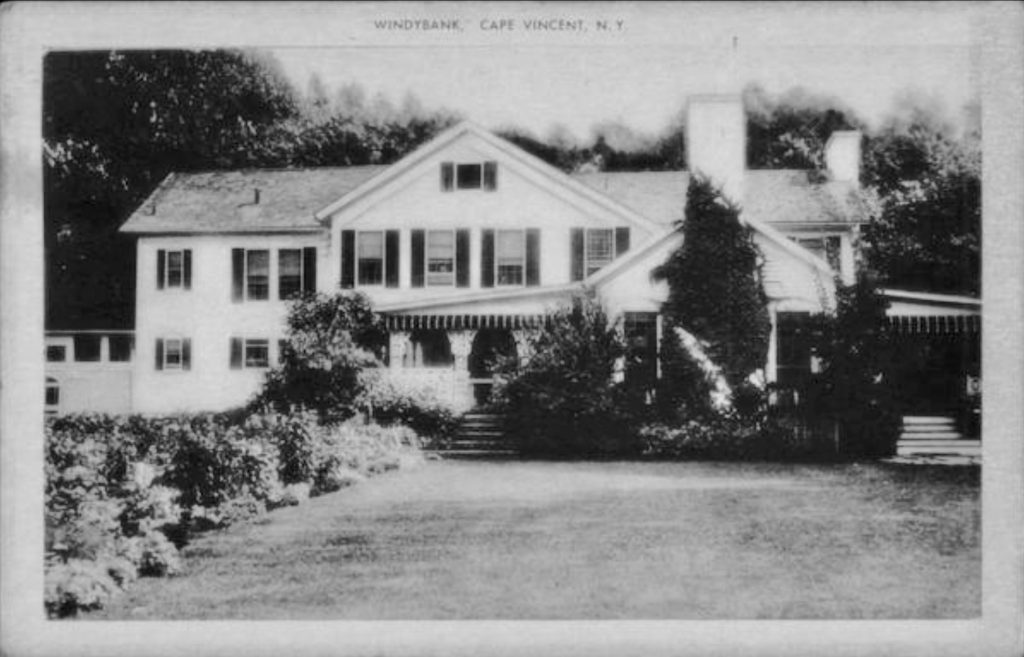
All of these stories helped to romanticize the history of the Cup and Saucer house, but in October 1963, the remains of the house were found. A nearby property, long-dubbed “Windybank,” situated on the corner of Broadway and Real, was purchased by Rochester businessman and former State Conservation commissioner Louis A. Wehle, who also happened to be a big Napoleon historian (and chairman of the Genesee Brewing Company.)
As the Watertown Daily Times noted, “finding the remains of the legendary, grotesque house…was not done by chance.” The article noted–
Mr. Wehle planned the search, which was launched last week by a local contractor.
The stone foundation, a unique piping system and other parts of the house are being revealed as a digging device scoops trenches five to eight feet deep in the sloping lawn of the property Mr. Wehle purchased from the estate of Mrs. Alexander H. Rutherford. The property is known locally as “Windybank” and fronts on Broadway.
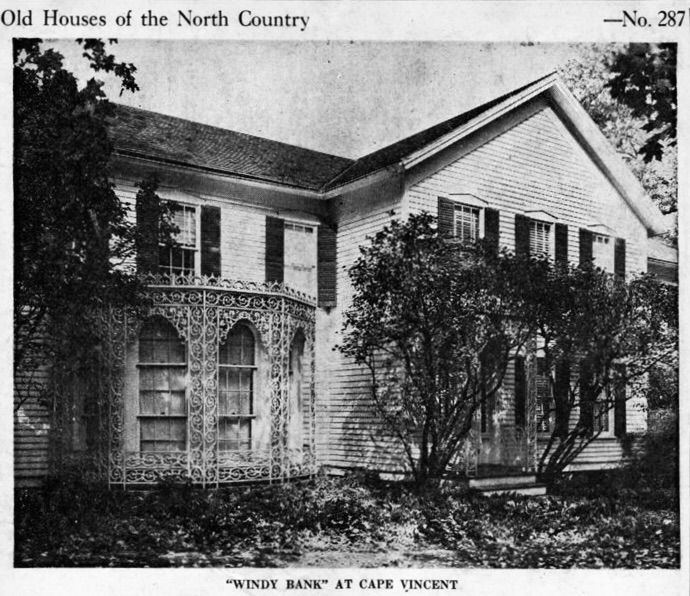
The excavation, according to The Times, found—
- Lengthy stretches of stone foundation wall
- Charred pieces of wood about five feet below ground.
- Portions of a flagstone floor believed to have been the basement.
- A stone area at one side with old-type, yellow mortar, believed to have been the cistern.
- Fragments of a marble-like vase, apparently of large size
- Hand-made bricks of various sizes, probably from a fireplace.
- A number of old-appearing locks.
- An unusual system of tin pipes in circular banks, usually of 13.
Unfortunately for the myth, no tunnels were discovered during the excavation. A small stone passageway was located about a foot and a half in diameter, but it was believed to have been used for water runoff as it ran approximately 150 feet to the drain into the river.
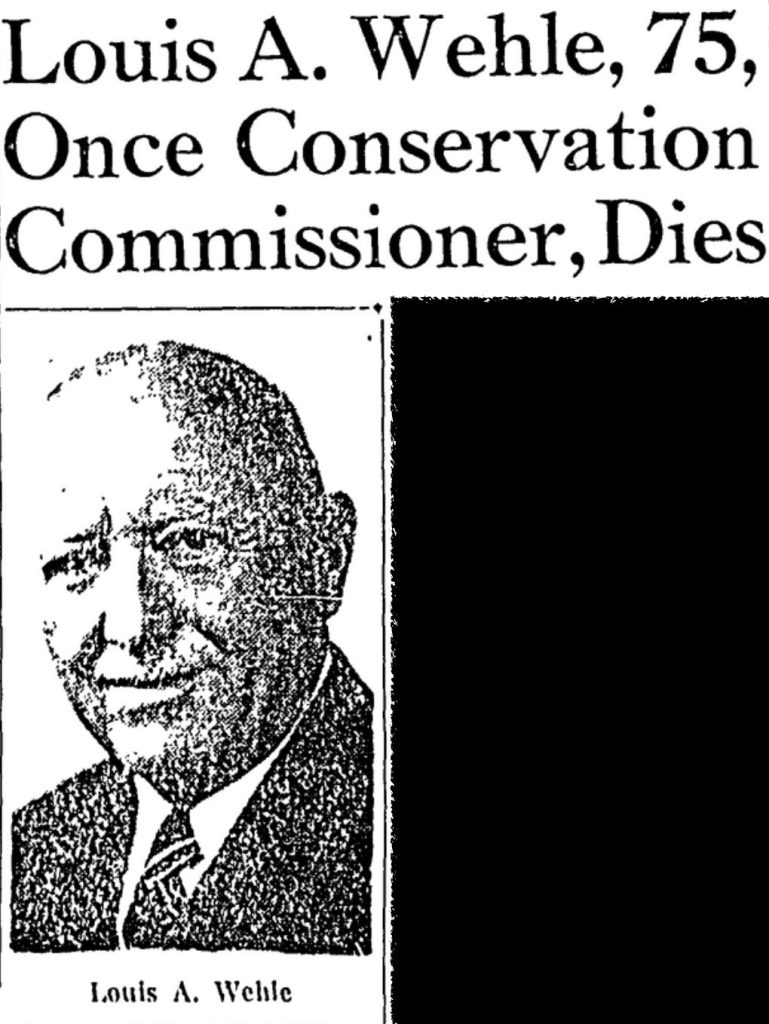
Before his death in 1964. Mr. Wehle proposed turning over Windybank for use as a museum and stated he would like to see the Cup and Saucer house replicated on its original site. The museum, he had hoped, would house Napoleonic artifacts from the Emperor’s era, and Mr. Wehle had worked a variety of routes through the Government in both Washington D.C. and Paris, France, to obtain any such items.
Despite interest from both sides, Mr. Wehle passed away in November of 1964 and without a champion, the proposals he set forth never came to fruition. Fortunately, he lived long enough to find the ruins of the famed Cup and Saucer house.
